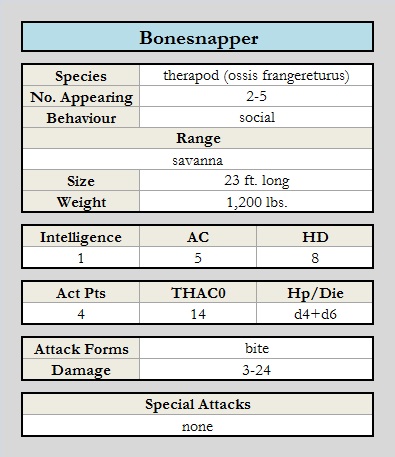Difference between revisions of "Bonesnapper"
m |
(Import from Tao's wiki. Image needed.) |
||
| Line 1: | Line 1: | ||
| − | + | [[File:Bonesnapper image.jpg|440px|left|Bonesnapper]][[File:Bonesnapper chart.jpg|right]] | |
| + | |||
| + | A lightly built bipedal [[Identify Amphibians & Reptiles (sage ability)|reptile]] with a long tail and massive head, with strong hind limbs for balance and claws not used for fighting. The creature is rarely found not in the company of another of its kind, most likely a female and offspring. | ||
| + | |||
| + | The offspring will remain with the parents into adulthood, until encountering another family group when water becomes scarce after the commencement of the dry season. Both groups will intermingle for this period as water remains short, before splitting off (with new relationships formed) once the dry season has ended. | ||
| + | |||
| + | The beasts are voracious eaters and will swarm large prey (above a thousand pounds) when encountered. They have been known to ignore smaller, less meaty prey, such as a party on foot, particularly in the dry season, preferring to save their energy for heavier prey that is bound to approach the water hole around which they hunt. They will loll during the daylight hours and prefer to hunt for three to four hours in the evening, when the air is still warm and light is diminishing. They will lay in a close pile during the night and hunt briefly in the morning. | ||
See [[Bestiary]]. | See [[Bestiary]]. | ||
[[Category:Bestiary]] | [[Category:Bestiary]] | ||
Revision as of 19:32, 12 February 2020
A lightly built bipedal reptile with a long tail and massive head, with strong hind limbs for balance and claws not used for fighting. The creature is rarely found not in the company of another of its kind, most likely a female and offspring.
The offspring will remain with the parents into adulthood, until encountering another family group when water becomes scarce after the commencement of the dry season. Both groups will intermingle for this period as water remains short, before splitting off (with new relationships formed) once the dry season has ended.
The beasts are voracious eaters and will swarm large prey (above a thousand pounds) when encountered. They have been known to ignore smaller, less meaty prey, such as a party on foot, particularly in the dry season, preferring to save their energy for heavier prey that is bound to approach the water hole around which they hunt. They will loll during the daylight hours and prefer to hunt for three to four hours in the evening, when the air is still warm and light is diminishing. They will lay in a close pile during the night and hunt briefly in the morning.
See Bestiary.
